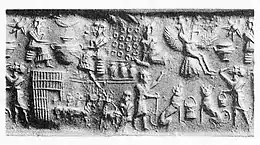| Etana 𒂊𒋫𒈾 | |
|---|---|
 Fragment of the Epic of Etana, Akkadian, c. 1895-1595 BC | |
| King of the First dynasty of Kish | |
| Reign | (probably fictional) |
| Predecessor | Arwium |
| Successor | Balih |
| Issue | Balih |

Etana (𒂊𒋫𒈾, E.TA.NA) was the thirteenth king of the first dynasty of Kish, according to the Sumerian King List. He is listed as the successor of Arwium, the son of Mashda, as king of Kish. The list also calls Etana "the shepherd, who ascended to heaven and consolidated all the foreign countries", and states that he ruled 1,560 years (some copies read 635) before being succeeded by his son Balih, said to have ruled 400 years. The kings on the early part of the SKL are usually not considered historical, except when they are mentioned in contemporary Early Dynastic documents. Etana is not one of them.[1]
Myth of Etana
A Babylonian legend says that Etana was desperate to have a child, until one day he helped save an eagle from starving, who then took him up into the sky to find the plant of birth. This led to the birth of his son, Balih.
In the detailed form of the legend, there is a tree with the eagle's nest at the top, and a serpent at the base. Both the serpent and eagle have promised Utu (the sun god) to behave well toward one another, and they share food with their children.
But one day, the eagle eats the serpent's children. The serpent comes back and cries. Utu tells the serpent to hide inside the stomach of a dead bull. The eagle goes down to eat the bull. The serpent captures the eagle, and throws him into a pit to die of hunger and thirst. Utu sends a man, Etana, to help the eagle. Etana saves the eagle, but he also asks the bird to find the plant of birth, in order to become father of a son. The eagle takes Etana up to the heaven of the god Anu, but Etana becomes afraid in the air and he goes back to the ground. He makes another attempt, and finds the plant of birth, enabling him to have Balih.
So far, versions in three languages have been found. The Old Babylonian version comes from Susa and Tell Harmal, the Middle Assyrian version comes from Assur, and the Standard version is from Nineveh.[2]
Analysis
Folklorist scholarship recognizes that the tale of Etana helping an eagle fits into the Aarne–Thompson–Uther tale type ATU 537, "The Eagle as helper: hero carried on the wings of a helpful eagle".[3][4][5][6][7] It has also been suggested that the myth of Etana originated the folk-type of later oral tradition.[8][9]
See also
References
- ↑ Marchesi, Gianni (2010). "The Sumerian King List and the Early History of Mesopotamia". M. G. Biga - M. Liverani (Eds.), ana turri gimilli: Studi dedicati al Padre Werner R. Mayer, S. J., da amici e allievi (Vicino Oriente - Quaderno 5; Roma): 231–248.
- ↑ Dalley 189.
- ↑ Annus, Amar. (2009). "Review Article: The Folk-Tales of Iraq and the Literary Traditions of Ancient Mesopotamia". In: Journal of Ancient Near Eastern Religions 9: 87-99. 10.1163/156921209X449170.
- ↑ Annus, Amar & Sarv, Mari. "The Ball Game Motif in the Gilgamesh Tradition and International Folklore". In: Mesopotamia in the Ancient World: Impact, Continuities, Parallels. Proceedings of the Seventh Symposium of the Melammu Project Held in Obergurgl, Austria, November 4-8, 2013. Münster: Ugarit-Verlag - Buch- und Medienhandel GmbH. 2015. pp. 289-290. ISBN 978-3-86835-128-6.
- ↑ Levin, Isidor. "Etana. Die keilschriftlichen Belege einer Erzählung". In: Fabula 8, Jahresband (1966): 1-63, doi: https://doi.org/10.1515/fabl.1966.8.1.1
- ↑ Aarne, Antti; Thompson, Stith. The types of the folktale: a classification and bibliography. Folklore Fellows Communications FFC no. 184. Helsinki: Academia Scientiarum Fennica, 1961. p. 193.
- ↑ Uther, Hans-Jörg (2004). The Types of International Folktales: A Classification and Bibliography, Based on the System of Antti Aarne and Stith Thompson. Suomalainen Tiedeakatemia, Academia Scientiarum Fennica. p. 313. ISBN 978-951-41-0963-8.
- ↑ Ferrer, Juan José Prat. Historia del Cuento Traditional. Urueña: Fundación Joaquín Diaz. 2013. pp. 52-53 (footnote nr. 96).
- ↑ Hasselblatt, Cornelius. Gedanken zur finnougristischen Literaturwissenschaft anlässlich eines gemeinsamen Motivs (ATU 301) in einem marischen und einem chantischen Roman. Juuret marin murteissa, latvus yltää Uraliin. Juhlakirja Sirkka Saarisen 60-vuotispäiväksi 21.12.2014. Helsinki: Suomalais-ugrilainen seura (Mémoires de la Société Finno-Ougrienne 270). 2014. p. 114.
Further reading
- Gurney, Oliver (2011). "A Bilingual Text Concerning Etana". Journal of the Royal Asiatic Society of Great Britain & Ireland. 67 (3): 459–466. doi:10.1017/S0035869X00087153. S2CID 162559350..
- Koubková, Evelyne. "Fortune and Misfortune of the Eagle in the Myth of Etana". In: Fortune and Misfortune in the Ancient Near East: Proceedings of the 60th Rencontre Assyriologique Internationale Warsaw, 21–25 July 2014. Winona Lake, Indiana: Eisenbraun. 2017. pp. 371-382. ISBN 978-1-57506-465-9
- Streck, Michael (2009). "Notes on the Old Babylonian Epics of Anzu and Etana". Journal of the American Oriental Society. 129 (3): 477–486. JSTOR 20789423..
- Valk, Jonathan (2021). "The Eagle and the Snake, or Anzû and bašmu? Another Mythological Dimension in the Epic of Etana". Journal of the American Oriental Society. 140 (4): 889–900. doi:10.7817/jameroriesoci.140.4.0889. hdl:1887/139005. S2CID 230537775..
- Winitzer, Abraham (2013). "Etana in Eden: New Light on the Mesopotamian and Biblical Tales in Their Semitic Context". Journal of the American Oriental Society. 133: 441–465. doi:10.7817/JAMERORIESOCI.133.3.0441..
_-_EnKi_(Sumerian).jpg.webp)
